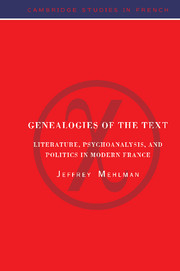Book contents
- Frontmatter
- Contents
- Acknowledgments
- 1 Introduction
- 2 Craniometry and criticism: notes on a Valéryan criss-cross
- 3 Literature and hospitality: Klossowski's Hamann
- 4 Literature and collaboration: Benoist-Méchin's return to Proust
- 5 “Pierre Menard, author of Don Quixote” again
- 6 Iphigenia 38: deconstruction, history, and the case of L'Arrêt de mort
- 7 Writing and deference: the politics of literary adulation
- 8 Perspectives: on Paul de Man and Le Soir
- 9 Prosopopeia revisited
- 10 The paranoid style in French prose: Lacan with Léon Bloy
- 11 The Holocaust comedies of “Emile Ajar”
- 12 Pour Sainte-Beuve: Maurice Blanchot, 10 March 1942
- 13 Flowers of evil: Paul Morand, the Collaboration, and literary history
- Appendix
- Notes
- Index
- Series list
7 - Writing and deference: the politics of literary adulation
Published online by Cambridge University Press: 19 January 2010
- Frontmatter
- Contents
- Acknowledgments
- 1 Introduction
- 2 Craniometry and criticism: notes on a Valéryan criss-cross
- 3 Literature and hospitality: Klossowski's Hamann
- 4 Literature and collaboration: Benoist-Méchin's return to Proust
- 5 “Pierre Menard, author of Don Quixote” again
- 6 Iphigenia 38: deconstruction, history, and the case of L'Arrêt de mort
- 7 Writing and deference: the politics of literary adulation
- 8 Perspectives: on Paul de Man and Le Soir
- 9 Prosopopeia revisited
- 10 The paranoid style in French prose: Lacan with Léon Bloy
- 11 The Holocaust comedies of “Emile Ajar”
- 12 Pour Sainte-Beuve: Maurice Blanchot, 10 March 1942
- 13 Flowers of evil: Paul Morand, the Collaboration, and literary history
- Appendix
- Notes
- Index
- Series list
Summary
There is an error – or infelicity – of translation in the English version of Grammatology which is so deeply anticipatory (if not performative) of the future of deconstruction in the United States as to deserve exemplary status. It concerns nothing less than the origin of language. Rousseau, it will be recalled, imagines passion's first utterance as a woman tracing with a stick (or “baguette”) the outline of her beloved's shadow on the ground. What sounds, he suggests, could ever match that inscription? Derrida, as well he might, reinscribes that “mouvement de baguette” as a chapter heading in his book. Here, now, is the English rendering of Rousseau: “How she could say things to her beloved, who traced his shadow with such pleasure! What sounds might she use to render this movement of the magic wand?” In the translation, it is the beloved who appears to be tracing his – own – shadow. The origin of language, that is, appears to have been lost in the translation. But the translation seems to convey its own myth: in between languages, the woman appears to have deferred to her beloved, to have handed him the stick or wand and invited him to speak (or trace) her love for him to himself. Communication has been lost, the inscription of difference (i.e., Derrida's argument) has been botched as the beloved is made to speak the other's admiration of himself…
It is tempting to view this sequence as a kind of primal scene of literary adulation – an obliteration of difference by deference (to refer to my own attempt at a mistranslation in the title of these remarks, although it is not nearly as eloquent as the case just quoted).
- Type
- Chapter
- Information
- Genealogies of the TextLiterature, Psychoanalysis, and Politics in Modern France, pp. 97 - 112Publisher: Cambridge University PressPrint publication year: 1995

